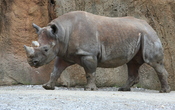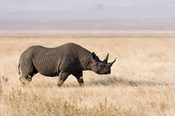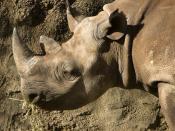Black Rhinoceros, otherwise known as Diceros bicornis, is an herbivorous mammal native to regions of eastern and central Africa. An adult rhino generally stands at 1.43 ÃÂ 1.60 metres high at the shoulders and weighs 800-1400 pounds. Two keratin horns can be found at the skull, which they use for defense, digging up roots, breaking branches, and intimidation. In addition, they have a pointed mouth, which is used to grasp branches and leaves, and coarse thick-layered skin that protects them from jagged rocks, sharp grasses, and thorns. Because rhinos have terrible eyesight, they often rely more on hearing and smell to identify their targets. They are typically solitary animals and have a reputation for being extremely aggressive. They browse for food in the morning and evening and spend the hotter parts of the day wallowing in the mud and sleeping in the shade.
RhinocerosÃÂ natural habitat is the savanna.
Savannas are a type of grassland biome and are located in Africa, Australia, southern Asia, and parts of South America. Temperatures and precipitation vary drastically depending on the season àin the dry season, temperatures may rise up to 48úC and have as little as ten cm of rain while in the wet season, savannas are warm and may receive as much as 120 cm of precipitation. Because of the lack of water, vegetation and wildlife is limited. Some examples of savanna vegetation include shrubs, acacia trees, and wild grasses. These trees and grasses have adapted and become accustomed to life with little water and scorching temperatures. Savannas are also the home to numerous land animals such as elephants, zebras, rhinos, buffalos, lions, leopards, cheetahs, crocodiles, antelopes, kangaroos, and ostriches. These animals must rely on their speed and camouflage in order to survive as the vast flat open areas provide...


